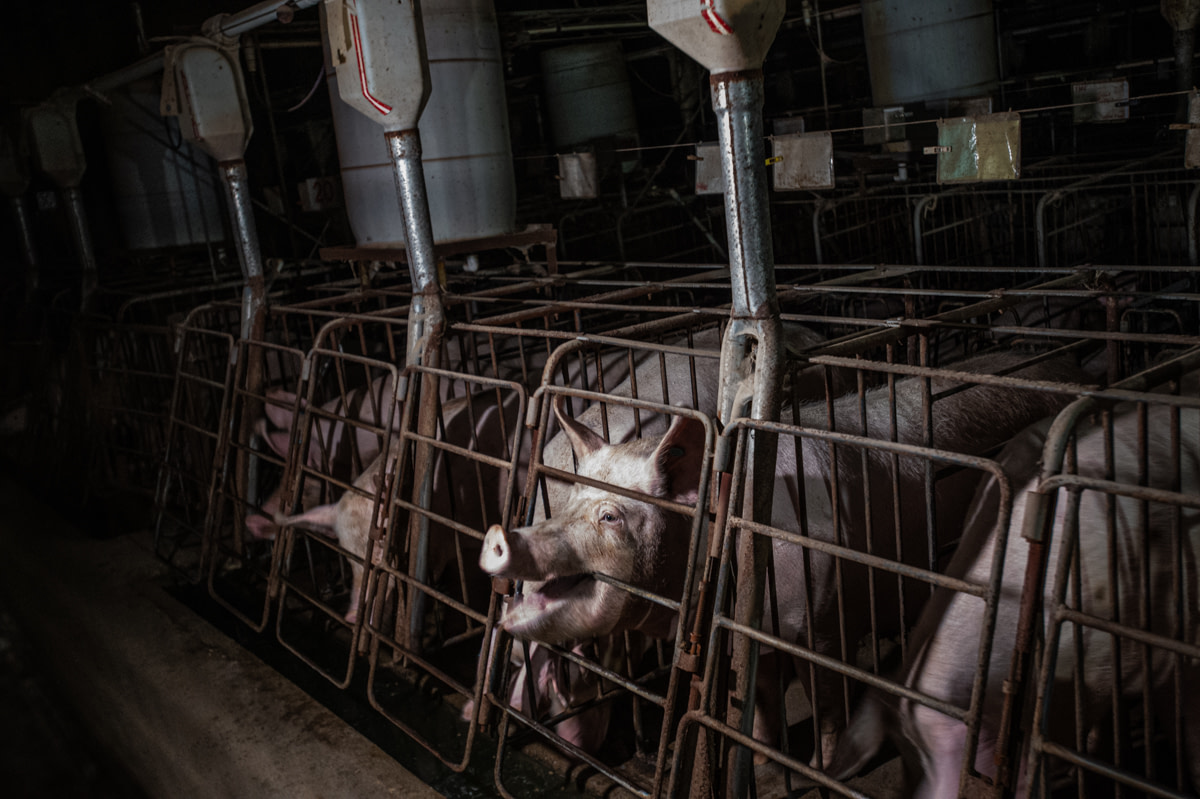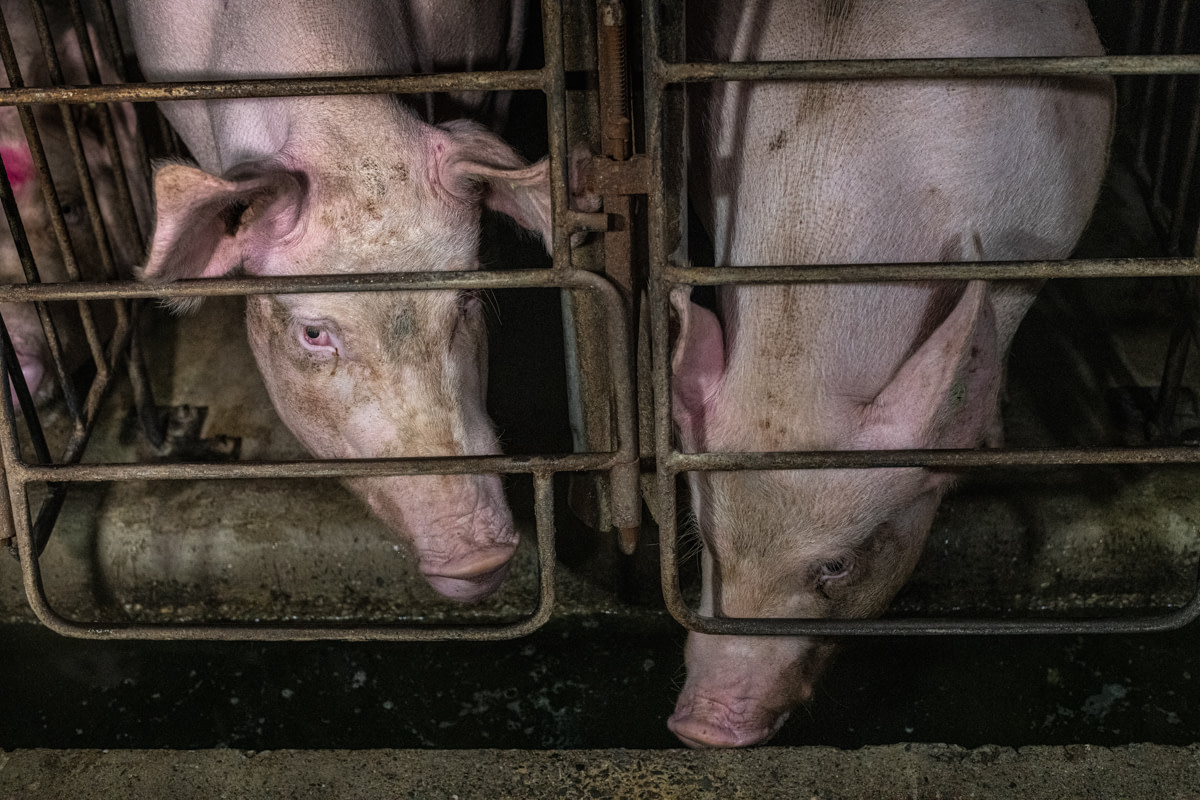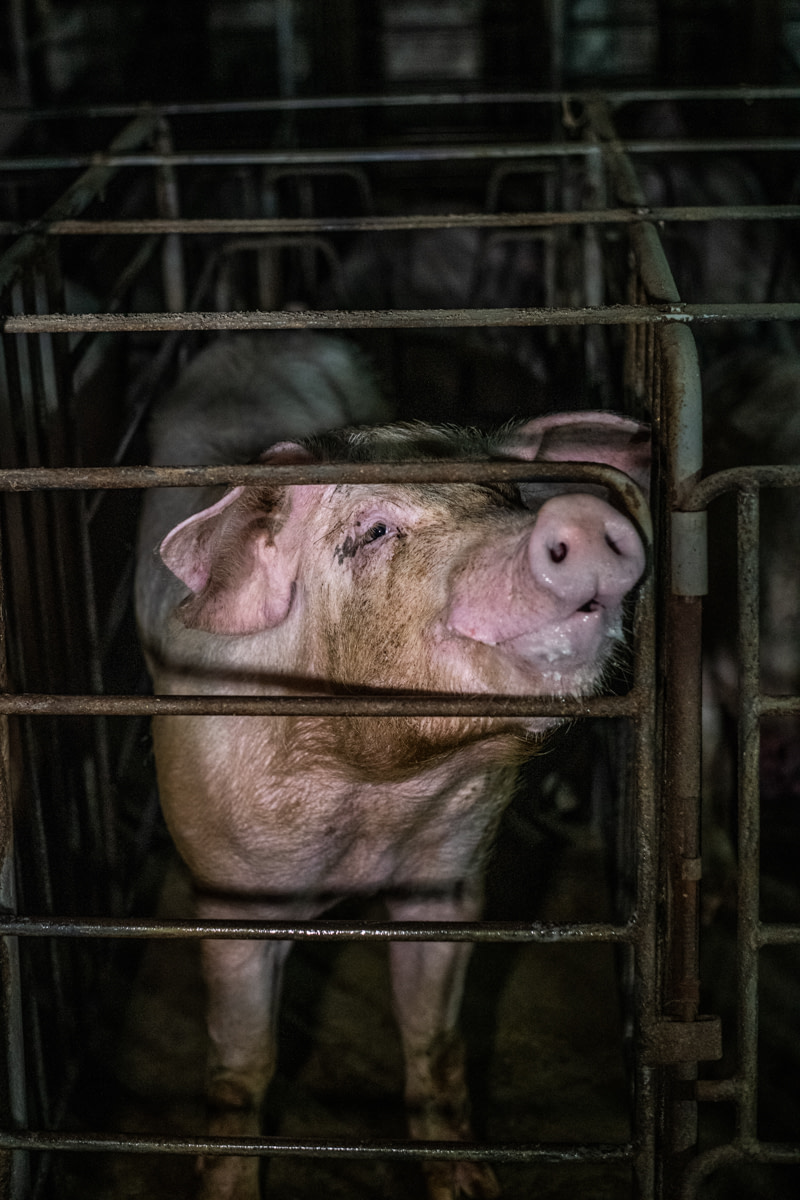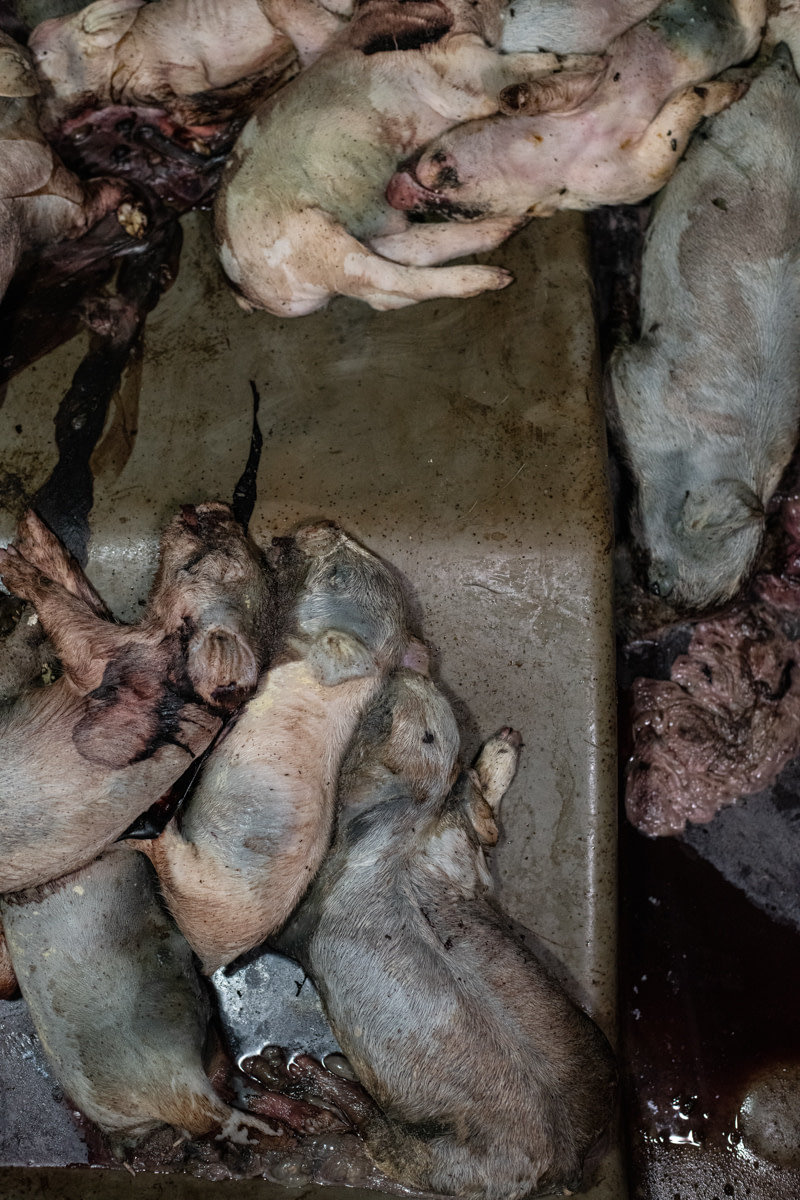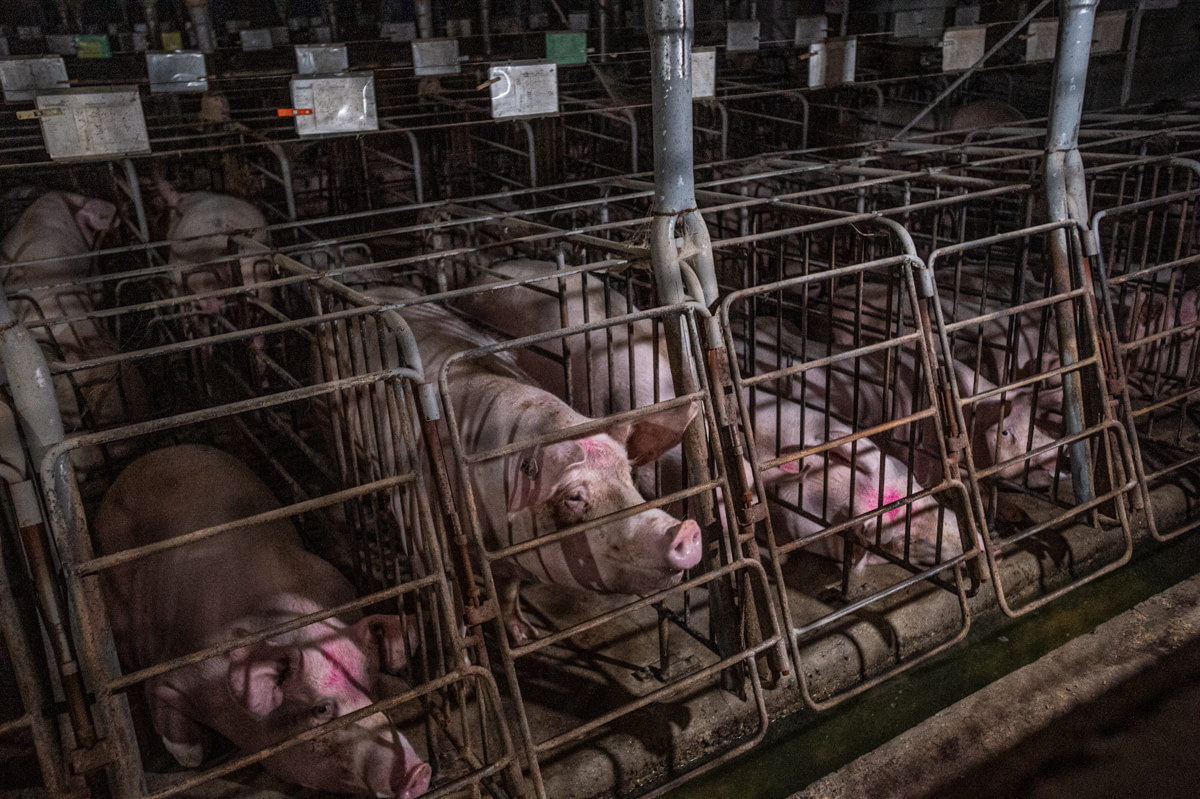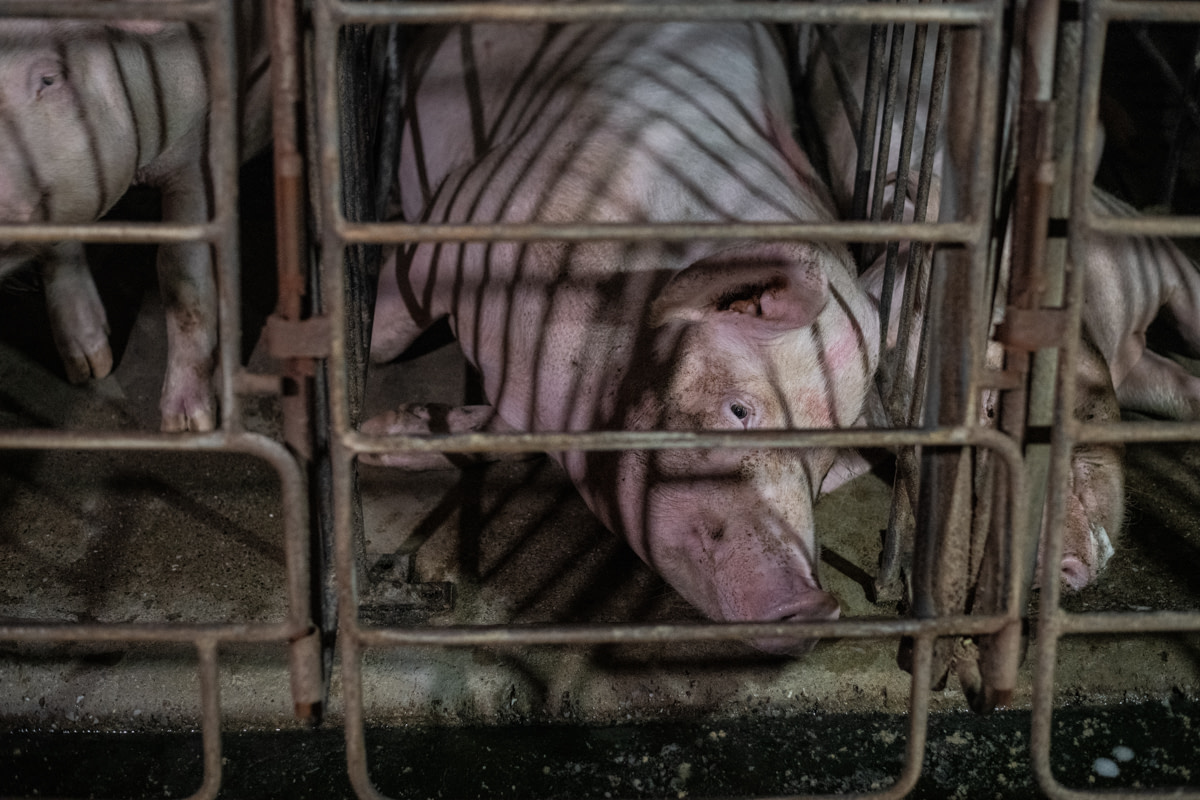Director of Global Fieldwork and Visual Content – Victoria de Martigny. Photo credit: Jo-Anne McArthur
Imagine having to live on the space of an airline seat for months on end: this is your only space for movement, for eating, drinking and going to the bathroom during that entire period of time. This is the reality for female pigs used for breeding in many parts of the world.
In September our photojournalists documented conditions inside a number of pig farms in North America, including the use of gestation crates – an industry standard practice similar in many parts of the world. These visuals offer a glimpse into the lives of pigs confined to these spaces.
Photographer: Jo-Anne McArthur
“We opened the door and stepped into a dingy hallway with puddles of mucky water on the floor. We couldn’t hear anything – though the acrid smell of urine and feces got stronger as we moved further inside. Everything was damp. I felt dirty just standing in the space.” ― Victoria de Martigny, animal photojournalist
Rows of sows live confined to gestation crates at an industrial pig farm in Quebec. Housed in bare, concrete-floored enclosures, The crates are large enough only for the sows to sit, stand, and lie down, but they cannot walk or turn around. A concrete wall is their only view. Canada, 2022.
Jo-Anne McArthur / We Animals
What Are Gestation Crates?
In many countries, gestation crates or sow stalls are the cages that impregnated adult female pigs, also referred to as sows, are kept in for all but the last five to ten days of their pregnancies. For the nearly four months of their gestation, they live inside a cage that is just larger than the size of their bodies, roughly two by seven feet. They can lie down, sit and stand but cannot turn around, walk, avoid the aggression from sows in neighbouring stalls or respond to temperature changes. Millions of pigs live in these extreme confines every day, despite many countries banning the practice on the grounds of animal welfare.
Our short film “Reclaim” helps to illustrate the size and reality of these cages.
Proponents of the crates claim that they are necessary to prevent fighting among the pigs, while those in opposition say that the crates constitute animal abuse.
Living in these conditions, often in darkness, does not allow for the animals to carry out their natural behaviours. Pigs are highly social and intelligent animals with complex communicative behaviour and maternal instincts. Research shows that when confined to gestation crates, pigs exhibit expressions of stress, fear, boredom and despondency. Gestation crates do not have bedding, and the pigs lie on slatted plastic, metal or concrete floors to allow for the flow of waste to be easily collected in pits beneath them. Nevertheless, pigs living in gestation crates, as seen in these photographs, are often living in their waste, and their bodies are filthy.
As a result of bans and restrictions in a number of states, in addition to pressure from major food retailers, nearly 40% of farmed pigs in the US today aren’t perpetually confined in gestation crates. But the pig industry wants to intervene with this progress towards improved animal welfare.
A sow makes eye contact with the camera from behind the bars of a gestation crate at an industrial pig farm in Quebec. She and those beside her live confined inside bare, concrete-floored enclosures. The crates are large enough only for the sows to sit, stand, and lie down, but they cannot walk or turn around. Canada, 2022.
Jo-Anne McArthur / We Animals
What Is Proposition 12?
Proposition 12, also known as the Farm Animal Confinement Initiative, is a law California voters passed in 2018 to define the minimum amount of space farmers must give to cows, pigs and chickens. Coming into full effect in 2022, Prop 12 is the strongest animal welfare law in the US.
The law applies to food products made from these animals and sold in California, even if the animals were raised and slaughtered outside of the state. Given that California imports most of its pig meat products from other states, the pig industry is arguing that this law will force a nationwide overhaul of its practices.
Rows of sows live confined to gestation crates at an industrial pig farm in Quebec. Housed in bare, concrete-floored enclosures, The crates are large enough only for the sows to sit, stand, and lie down, but they cannot walk or turn around. A concrete wall is their only view. Canada, 2022.
Jo-Anne McArthur / We Animals
On October 11, 2022, the Supreme Court will hear a case arguing that California’s Proposition 12 violates a US law by regulating pig producers and the pig market outside the state. Put simply, the pig industry is trying to overturn Prop 12.
Approximately two-thirds of US pig production uses gestation crates. Yet media coverage of this issue rarely shows the reality of these crates. Almost exclusively stories about this issue use photos of pigs in large pens or in fields, or of cute piglets, all of which fail to accurately show to readers the extreme confines pigs in gestation crates typically endure.
A sow looks out through the bars of her gestation crate while lying on its bare concrete floor at an industrial pig farm in Quebec. She and countless other sows live here confined within individual enclosures large enough only for them to sit, stand and lie down. The sows do not have enough space to walk or turn around. Canada, 2022.
Jo-Anne McArthur / We Animals
Rows of sows live confined to gestation crates at an industrial pig farm in Quebec. Housed in bare, concrete-floored enclosures, The crates are large enough only for the sows to sit, stand, and lie down, but they cannot walk or turn around. A concrete wall is their only view. Canada, 2022.
Jo-Anne McArthur / We Animals
In 2018, Californians overwhelmingly voted to make gestation crates illegal, with nearly 63% of respondents (around 7.5 million people) voting in favour of Prop 12. Animal protection organizations, veterinarians, as well as the general public are concerned Prop 12 is in jeopardy as corporate interests threaten to overturn democratic action.
Take Action
Sign this petition to protect California’s Proposition 12.
Help tell this important story. Use these new images of pigs inside gestation crates for your advocacy and communications around Proposition 12.
Data sources: The Humane League / Humane Society / Center for a Humane Economy / CDFA / The Guardian / The Washington Post / Ballotpedia / Vox
Photographer: Jo-Anne McArthur
Explore and download more visuals from this collection via our stock platform.


